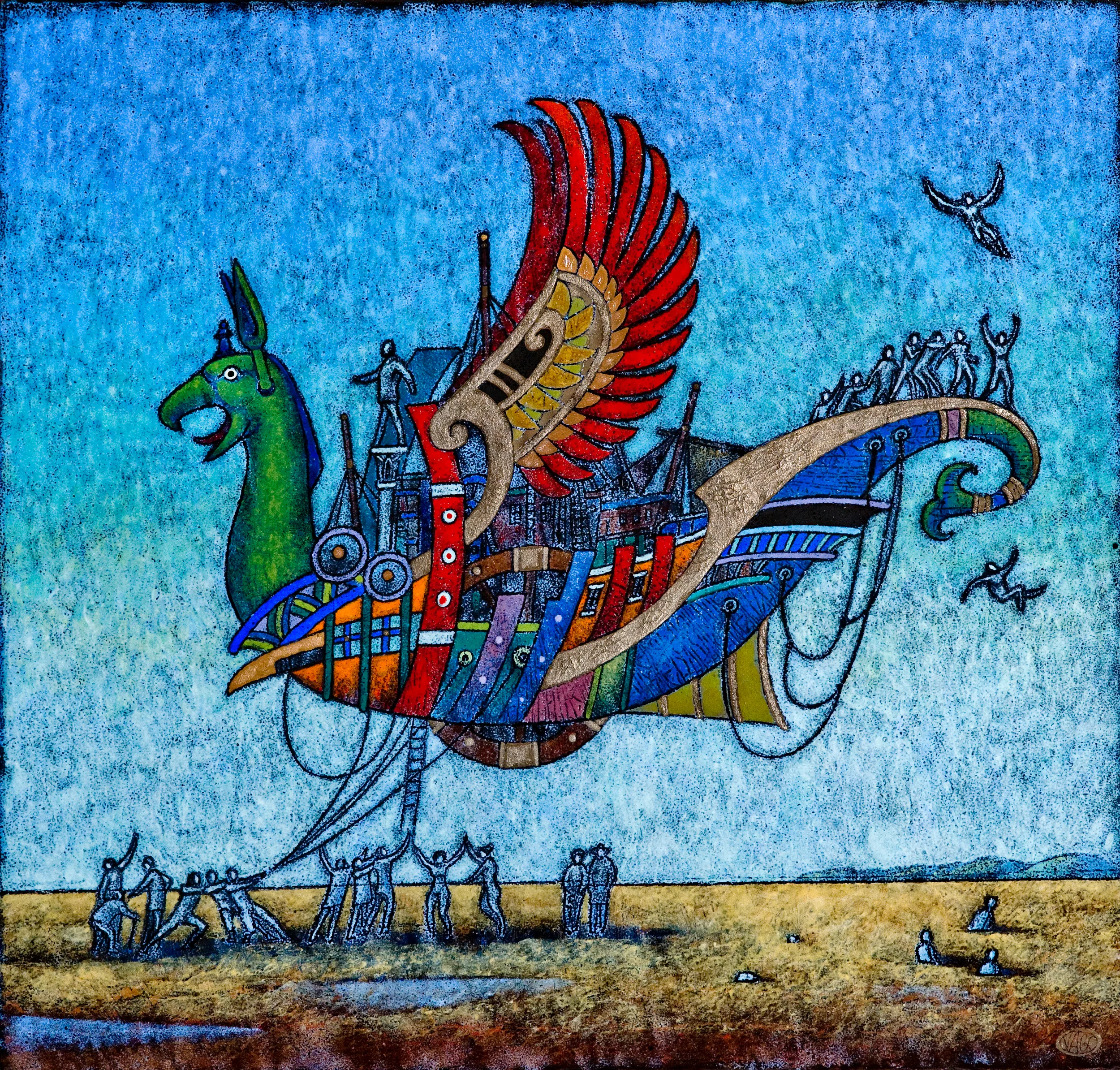NEWS | BIOGRAPY | THE ENAMEL | AWARDS | EXHIBITIONS | CINEFEST | FESTIVAL | GALLERY | WORKSHOPS | CONTACT
The Guardian of the Bluebird’s “Enamel Nest”
It might be surprising and might inspire jealousy that someone has already reached up to, and now guards the nest of the Bluebird of happiness.
István Vágó enamel artist has been working with enamel painting techniques for nearly 25 years. Both the material and the techniques are magical. During the process of gaining the proper skills the individual technique of the artist is forming, developing until they find their unique feature which is like a fingerprint. Then the style is born. In István Vágó’s case his attraction to history led him to the historical style, to the adaption of myths and legends. He likes to visit the fields of the most particular styles and trends. It is a challenge, a kind of deepening to elaborate a topic in renaissance or art deco style, or bravely mix the different styles like a collage.
Rugged path paved by glittering stones of hope, and girdled with deep pits of failure and despair, full of struggles has led to his present life. He has learnt from masters like Zsigmond Károlyi and Ernő Tolvaly, who made him realize even at his young age that he must not waste his talent, and made him focus his imagination luxuriating among the different techniques on the expression of his philosophical thoughts with means that can display even the subtle flutters of massive thoughts in a proper way to start an inner process in the beholder as well. Thus he exploits the sensual but mainly abstract, illusionistic and conceptual potentials of translucency, transparency, covering and repainting.
His works of art combine symbolism with the knowledge and credo of renaissance, while using the looming, fabulously warm colours of romanticism with wide range of decorative and narrative tools. These are the visual manifestations of a deep thinker further cogitating life. Most of his works express his ideas by figurative elements. Their message sometimes is only interpreted by colours, or by enigmatical details, backgrounds, and non-figurative elements surrounded with motifs. If we take the time to analyze the details of his works of art elaborated with the greatest care, we can find their deeper substance interwoven with philosophical background and historical knowledge, which is offered by a brilliant though limited technique. It is difficult to define his style, however, it can be risked by analyzing his recent works of art, either his jewels or his smaller or larger pictures that in a more mature style of the ornamental erudition of Miksa Róth and the surrealistic world of Gulácsy he increasingly represents the pre-Raphaelite-symbolist trend, in which the pre-Raphaelite romantic traces can be observed in the figurative illustrations and motifs.
“To express the inexpressible”
This technique has French origin, and derives from Limoges type enamel and within that it is among the so-called painted enamels, i.e. painting enamel colours on metal plates, which can be compared to painters’ work in fine art, watercolour or oil paintings.
At the beginning of his career, when he was a young but mature artist, his work was appreciated by masters like Endre Szász and Mihály Kátay. However, the success in his home country was to come later. In 1997 Walker Connor, a young American recommended his works of art to the Denver Creek Art Festival, where his first appearance brought a reward: in 1998 he won first prize, and then every year he obtained greater and greater success and received appreciation at several art programmes, he was invited to prestigious exhibitions, musters. (Including: 1999 USA Cherry Creek Art Festival, Denver, 2000 USA American Craft Show, New York, 2001 USA Winter Park Arts Festival, Orlando, 2001 USA Long Park Arts Festival, Lancaster, 2005-2009 USA Sausalito Arts Festival, San Francisco). Between 2000 and 2014 almost every year he won a prize at the Three Rivers Arts Festival in Pittsburgh, in 2015 he was prized by the jury and in 2016 he won Festival Award.
The symbolic pictures, the works of art using the traditional figures of the Hungarian and other European culture with their specific mystery, extra knowledge and symbols have found their way to the homes of the art lovers of the New World, so the success has brought patrons, sponsors, and in the meantime, he has become acknowledged in his homeland, in Hungary, too. The emblem of Miskolc International Film Festival, the Jamison Cinefest Prize, which has been given to several Hungarian and international actors, directors and cameramen, was created by István Vágó.
However, as the time was passing the message of his works of art has changed; it has become even more mature, even deeper. The artist disappointed with the intrigues of history has turned to the roots of philosophy and to new ways offered by literature (Camus), which has filled his work with a new content that may fascinate even the people of his homeland. His target is to „to express the inexpressible”, to point out the correlation of the elements of existence with symbols, to show the ancient myths in a 21st century style, i.e. the visual expression of hardly explicable or inexplicable ideas. Thus in his works of art the visual signs carry a symbolic, emotional meaning but they are not far from reality, they illustrate fascinating topics which are eternal and have a message even for today’s people.
Renáta Herczeg
art historian
2016



